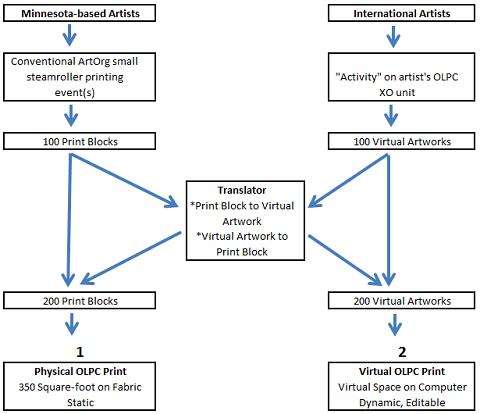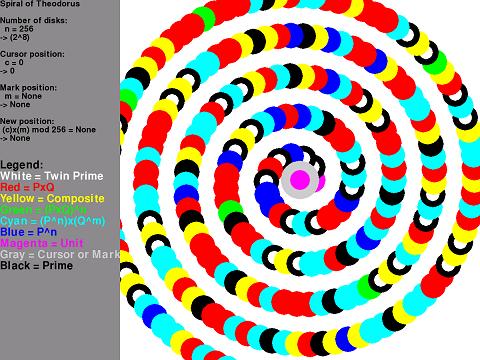The Printed and Unprinted Print
Summary:
Our team will create two artworks with 200 artists. 100 physical submissions will come from Minnesota, and 100 virtual submissions will come over a custom application written for the One Laptop Per Child (OLPC) platform. There will be a transposition of the 100 virtual works to the physical, and the 100 physical works to the virtual. We can thereby create dual artworks for exhibition: 1) a static 200-element, 350-square-foot physical artwork on fabric by relief printing, and 2) a dynamic 200-element virtual artwork by digital means.

Description:
The novel aspects of this project are a) creative submissions through the One Laptop Per Child computer platform, and b) the creation of a summary collaborative work that exists in virtual space. We believe to understand the project criteria and that novel parts of the project are experimental, they exist at the intersection of at art and technology, they are network-based, and both inactive and participatory.
We are using an underlying framework for our project that is strong and has been built over the last few years. Our group has founded a public printmaking event that has involved over 100 venues and nearly 10,000 kids and adults. Paper prints are created at each event but we have also saved the print blocks and reprinted them in large collaborative works that will also be submitted as work samples to this proposal: The Big Print, The Peace Caterpillar, and The St. Cloud Cult Print. The core event is very strong, and the large collaborative works dramatic. This arc of activity has received some acknowledgement.
This “The Printed and Unprinted Print” project deviates from our standard fare because we are taking half of the collaborative artistic submissions by virtual means rather than in person, and we will use a custom application written for the One Laptop Per Child platform.
The OLPC project has over 2 million units installed worldwide. In some countries, such as Uruguay, every child from the ages of 6 to 12 has an OLPC XO unit. Our artist team member Peter Hammer has been writing software for the OLPC XO since 2007. Several examples of his interactive visual tools for the OLPC platform are shown in Peter’s work samples. We will also make use of our supporting collaborator Paolo Dini, who in addition to having worked for MIT Media Lab Europe, has worked with entities involved in OLPC implementation in several countries.
The “The Printed and Unprinted Print” project also deviates from standard fare because there are two collaborative works which result.
1) The Physical OLPC Print: This work will be a relief-printed manifestation of the print blocks (and the translated virtual artworks) on fabric. For example, this work can be hung in a gallery for exhibition, or be sent to a participating site where some of the virtual submissions came from. This work will be printed by hand with relief-printing materials—and benefit from that traditional richness.
2) The Virtual OLPC Print: This work will exist in virtual space and include the virtual submissions (and the print blocks that have been translated to the virtual). The work will be accessed by all collaborating artists and the public. This work could be made dynamic and change to the wishes of the viewer. Certain aspects of this virtual display could include a) changing the colors of the blocks to create a different overall design, b) tiling other than a two-dimensional surface with the 200 artworks—for example the “Virtual OLCP Print” could be a rotatable cube.
As indicated by the block diagram graphic, we must translate the two groups of submissions into each other’s format. The virtual group of 100 artworks will be made into print blocks, and the 100 print blocks must be digitized into a form that can be worked with in the computer. Our supporting collaborator Doug Wornson has been working in the automation industry for over 20 years, and we will attempt to digitize the actual print blocks by a machine vision system. Conversely we will attempt to cut materials for the print blocks from the 100 virtual submissions by automatic means. Depending on budgetary constraints, the project can be successfully completed without automating these aspects, because these steps can be done by hand to no visible detriment to the final results.
Finally, the overall design of the two final collaborative works must be strong, and the interfaces easy to use. The project makes use of the talents of team artist Kari Alberg (who created overall designs to The Big Print, Peace Caterpillar, and St. Cloud Cult Print), and supporting collaborator Greg Mattern who is an established video editor to fulfill these roles.
We note that many of our team are engineers, and groups have formed around engineers and artists in the past. The Experiments in Art and Technology organization (E. A.T.) spoke in their 1967 manifesto of eliminating the separation between the individual and technological change, but also by “collaboration between groups unrealistically developing in isolation”. We also note that our project has aspects that deal with the concept of “the commons” and “community”. The Printed and Unprinted Print project may be a commons which may in fact foster community.
Work Samples List:
1) Alberg/Machacek: The Big Print, 2010, relief-printed and painted 5000 square-foot collaboration with 1180 artists.
2) Alberg/Machacek: The Peace Caterpillar, 2010, relief-printed and painted 100-foot-long collaboration with 350 artists.
3) Alberg/Machacek: The St. Cloud Cult Print, 2011, relief-printed and painted 350 square-foot collaboration with three paintings and 250 artists.
4) Peter Hammer: Pypette Showing Gear Code. 2010. This is a screen shot of my main work over the last three years: a python development system running on the olpc XO, created using only XO resources and tools. This tool was used to create the code underlying all of the other screenshots. The tool was designed to appear similar to the quite limited standard tool supplied with the XO, pippy, while offering vastly expanded functionality. All visible icons, with the exception of the two in the upper right, which are standard, were designed by me. The code window shows some comment lines from the gear generation program. The output window at the bottom shows the beginning of the result of running the program: a scalable vector graphics file (.svg file) viewable by any web browser. All coding for the AOV project will be done on an XO using Pypette. Part of the purpose of this is to demonstrate just how much can be done with this modest machine, given the necessary knowledge and perseverance.
5) Peter Hammer: Primes on Spiral of Theodorus, 2010. This screenshots is from an interactive program that maps the number line into the plane according to varying rules, and color codes the numbers according to their prime factorization. This is the most elementary mapping, where the number line is simply wrapped in a spiral. Each disk represents a number. The gray ring in the center is the cursor, which may be moved along the number line, and information about the number inside the cursor is displayed in the panel on the left.
Bio and Resume
Dave Machacek: Resume
Paolo Dini: Resume

Artists
- Kari Alberg
- Peter Hammer
- Dave Machacek
Collaborators
- Paolo Dini
- Greg Mattern
- Doug Wornson
Background Links
Physical OLPC Print
A set of relief-printed elements arranged in a mural on fabric.
| Artists | 200 |
| Year | 2011 |
| Art Size | 16 by 22 feet |
| Edition | 1 |
| Publisher | ArtOrg |
Virtual OLPC Print
A set of digital elements arranged in a virtual space.
| Artists | 200 |
| Year | 2011 |
| Art Size | virtual |
| Edition | open |
| Publisher | ArtOrg |
Videos
Reactions to The Big Print
Inspiration: Artist Aaron Koblin